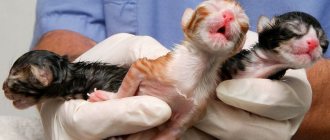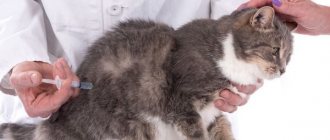Being a caring owner means, among other things, responding in a timely manner to signs of health problems in your pet. A kitten's blood is certainly one of these, and it almost certainly indicates some kind of injury or disease. This should not happen in a completely healthy animal. Therefore, to help the owners, in this article the Murkoshi team will talk about the main cases when a cat bleeds, why this happens and what needs to be done in such situations.
1) Why a cat may bleed 2) Blood in the stool 3) Blood in the urine 4) Treatment
Why might a cat bleed?
If you notice that your cat is bleeding, try to identify the source of the bleeding. Of course, we are not talking about a situation where there is heavy bleeding - in this case, you should immediately take the cat to a veterinary clinic. So, if you find traces of blood somewhere on the fur, then perhaps there is nothing to worry too much about. Most likely, this is a minor wound caused by a curious cat being slightly injured by an object. Especially if the cat does not go outside. If the wound is small, then simply treating it with peroxide is enough.
Read more about cat wounds and first aid: How to treat cat wounds
If your cat constantly walks outside, we still recommend (just in case) to show it to the veterinarian, and then reconsider your attitude towards self-walking. There is nothing for a domestic cat to do outside, but the risk of getting lost, getting hurt or dying there is very high. Even if the cat has a small wound now, next time he may come with more serious damage. Or don't come at all.
Read more about the dangers of self-walking: What is cat self-walking and why is it dangerous?
It also happens that a cat bleeds not from a wound, but from natural orifices (mouth, nose, anus, vagina, ears). This condition is very dangerous because the causes of such bleeding are usually serious. To figure out why your cat is bleeding, you need to thoroughly examine your pet at a veterinary clinic. For example, the reason may lie in a disease of the internal organs, or in the fact that a foreign body is stuck inside, or in a tumor, or there is a problem with blood clotting. In any case, you should never make a diagnosis yourself. As you can see, there are many reasons why a cat is bleeding. It is impossible for a person without special education and work experience to understand them. And improper treatment will not only lead to the disease getting worse, but also to the fact that internal organs may stop functioning normally.
Blood in stool
It is possible that you will find blood not on the cat's body, but in the feces. Sometimes this phenomenon is not something terrible. For example, if there was little blood and this case turned out to be an isolated incident, then most likely the reason is that during defecation, hard feces scratched the mucous membrane of the rectum and damaged the anal sphincter. To prevent this from happening in the future, provide your cat with constant access to fresh water. You can also give not only dry, but also wet food of a similar class. If blood is constantly detected in the stool, then you need to consult a specialist. He will conduct an examination and identify the true cause. The problem may be caused by the following reasons:
- bacterial infection; - helminths; - allergic reaction; - polyps and tumors in the intestines; - poor blood clotting (in this case, most likely, bleeding will be found not only in the stool).
Any of these problems are extremely serious and can threaten the health and even life of the cat. And each of them requires specific treatment. Therefore, it is important to make the correct diagnosis as quickly as possible and prescribe an appropriate course of therapy.
Blood in urine
Blood in a cat's urine is called hematuria. This always indicates the presence of some disease or pathology. The difficulty is that if a cat uses a litter tray, it is often very difficult to notice blood in the urine. However, owners should be alert to changes in the color of urine or bloody spots or blood clots in the tray. In this case, you should immediately contact a veterinarian. The causes of blood in a kitten's urine can be:
1. Inflammatory processes in the kidneys, bladder or ureters. This is an extremely alarming symptom. In addition to the fact that it is simply painful for the animal to relieve itself, due to these inflammatory processes, the infection can spread throughout the body, because blood is forced through the kidneys. And if they are colonized by bacteria or viruses, then each “batch” of blood filtered by the kidneys will be infected. The most common cause associated with bladder inflammation is cystitis. Urgent medical attention is needed, including anti-inflammatory and antibacterial drugs, before the pet’s condition worsens.
2. Urolithiasis. This disease deserves special mention. When stones pass, their sharp edges injure the tissues of the urinary system - this provokes internal bleeding. If treatment is delayed, it can lead to the death of the animal. Urolithiasis often develops due to poor nutrition, so to prevent it, you should immediately provide your cat with a proper and balanced diet - super premium or holistic food that contains all the necessary vitamins and minerals. At the Murkosha shelter, we feed our charges with this very food, so they feel vigorous and healthy even in old age. We also remind you that your cat should always have access to fresh drinking water.
Read more: What to do if your cat has urolithiasis
3. Internal organ injuries and systemic diseases. The causes of hematuria can be, for example, liver and blood diseases, infectious processes in the body, and heart failure.
4. Tumor in the urinary tract. In this case, blood in the cat’s urine is accompanied by painful urination. In older animals, this may indicate the presence of advanced cancer.
5. Poisoning or side effects of medications. Do not self-medicate under any circumstances, and certainly do not give your cat human medications without consulting a veterinarian! Because of this, animals experience poisoning, accompanied by internal bleeding. Often these are kidney bleeding, which causes blood to appear from the urethra. Also, internal bleeding can be caused by various chemicals: dishwashing detergents, washing powder, perfumes, varnishes, glue, etc.
6. Helminths. Worms can cause blood in a kitten's urine if they infect the kidneys or bladder.
Read more about how to get rid of helminths: How to get rid of worms in cats?
Reasons for appearance
Normally, bloody discharge appears in a cat for the following reasons:
- Estrus. The discharge indicates that the cat is ready to mate and bear offspring; its duration is several days. At the same time, the secretion does not have an unpleasant odor, and when the animal licks itself, it does not leave marks on surrounding objects. It is important to remember that spotting during estrus is typical for untied cats. After the first birth they will always be transparent.
- During pregnancy. Normally, during the entire period when a cat is bearing offspring, she should not be bothered by discharge. Ichor may be released during contractions.
- After the birth of kittens. The animal’s body is recovering, so during the first three weeks after birth, the presence of spotting is considered normal. In this case, the pet should feel well, eat as usual and carefully care for the offspring. If the discharge continues for more than the specified period, and the cat becomes lethargic, then it needs to be shown to a veterinarian.
A small amount of blood from the uterus can be released in cats only for the reasons described above. If the secretion is copious, foul-smelling, or includes particles, then this may be a symptom of many diseases of the genitourinary system or a sign of uterine bleeding.
Treatment
The best thing that owners can do if they find blood in a cat’s urine is to show it to a doctor as soon as possible, collect the urine for analysis, and then strictly adhere to the specialist’s instructions. As you can see, there are many reasons why a cat has blood (in urine, feces, on the body), and each of them requires its own treatment regimen. It is not possible to describe them all in one article. Cats are usually prescribed antibacterial and anti-inflammatory medications, and painkillers may be prescribed. The doctor may also prescribe nutritional therapy. If a cat develops dehydration due to poisoning, it is given IV drips with saline and glucose. Also, in case of poisoning, vitamin K and drugs to improve blood clotting are used. Parasitic diseases are treated with deworming. In some cases (polyps, tumors, kidney stones) surgery will be required.
Thus, a cat’s blood usually indicates problems that lie within the body. There may be many specific reasons, but they are all quite serious and require timely treatment. “Murkosha” reminds: no self-medication! If you notice blood in your cat's discharge or bleeding, seek professional help immediately! Compliance with this rule is the key to the health and long life of your pet.
Complications leading to bleeding after childbirth
Let's look at the symptom of what complication postpartum bleeding can be. Let's start with the reason mentioned above - incomplete expulsion of kittens or placenta.
Many inexperienced owners believe that the end of pushing indicates the completion of the birth process. However, if the cat was not examined by ultrasound during the last stage of pregnancy, the owner cannot know the exact number of kittens that were due to be born. In this case, there is a risk that a dead kitten or the placenta of the last born cub will remain in the uterine cavity.
With such complications, the first alarming symptoms appear within 24-72 hours after birth.
- The cat's appetite rapidly deteriorates, apathy appears, and as a result of painful sensations, the young mother abandons the kittens.
- Brown discharge with a small amount of coagulated blood appears from the cat's vagina.
- As complications develop, baseline body temperature constantly rises.
- When you palpate your cat's abdomen, you will find that the abdominal muscles are tense and she is reacting to pain.
If symptoms are detected in time and correctly interpreted, conservative treatment is used to resolve the situation. After stimulating additional pushing and cleaning the uterine cavity, the woman in labor is prescribed a course of broad-spectrum antibiotics to prevent the development of a bacterial infection. If more than a day has passed since the birth, the veterinarian will have to perform castration - remove the uterus.
The second common complication is metritis or inflammation of the uterus. The complication can develop within 3 days after the completion of labor. When metritis develops, the cat looks depressed and clearly sick. When measuring the temperature, it will be found that it is elevated. From the first day of the development of the malaise, the young mother refuses to eat, abandons the kittens and ignores drinking, which quickly leads to dehydration.
With metritis, a cat may develop diarrhea and vomiting, against which severe dehydration is inevitable.
With metritis, bloody discharge from the genital tract has a characteristic unpleasant odor. Quite often there is pus in the blood. When you feel the belly of a young mother, you will feel that the abdominal wall is tense. Despite severe pain and muscle tone, an enlarged uterus is felt upon palpation.
Metritis develops against the background of rapid proliferation of pathogenic bacteria. The condition is alleviated by a course of antibiotics, but treatment may not be effective if the spectrum of the drug is chosen incorrectly. Positive dynamics should appear on the first day after the start of treatment. If no positive dynamics are observed after 24–48 hours, the only way to save the cat is through surgery followed by removal of the uterus.
A less common, but no less dangerous complication is uterine prolapse . Typically, such complications result from a difficult birth. In human terms, during childbirth, the cat literally pushes out or inverts the uterus, which leads to protrusion from the birth canal and severe bleeding.
With prolapse, the clinical picture develops very quickly, and the symptoms are very similar to rupture of the uterine walls. In both cases, severe bleeding is observed, which must be stopped as soon as possible. Further treatment is carried out with the help of surgery, as a result of which the uterus will be removed and its stump will be reduced.
The most dangerous complication after giving birth to a cat is perforation of the uterus or rupture of its walls . Such a violation does not occur without a reason; usually the cat has problems during pregnancy. Prolonged labor, when the cat is in contractions for more than 12 hours or pushing for more than 2 hours, can also cause rupture of the walls of the uterus.
Ruptures in the walls of the birth canal are often caused by manipulations performed by the owner or veterinarian when the kitten gets stuck during expulsion. To remove a stuck kitten from the birth canal, it is necessary to use lubricants, at least Vaseline oil. The kitten is pulled up only during pushing! Forced or abrupt removal of the kitten from the birth canal is guaranteed to lead to overstretching or rupture.
Uterine rupture can occur if the owner tries to pull the failed placenta by the umbilical cord. Such manipulations are strictly prohibited and are not carried out by veterinarians. Medications are used to stimulate expulsion of the placenta.
Many inexperienced owners, who have received incomplete or unreliable information, consider stimulants to be very dangerous and unknowingly risk the life of their pet.
Labor stimulants can actually cause harm if used inappropriately or in the wrong dose. However, their use is safer than forcibly removing the placenta from the uterine cavity.











